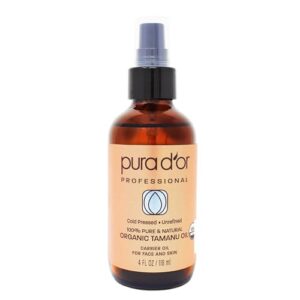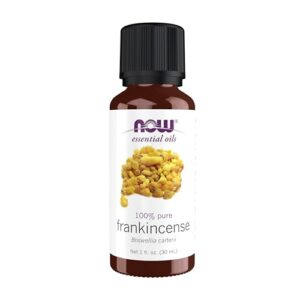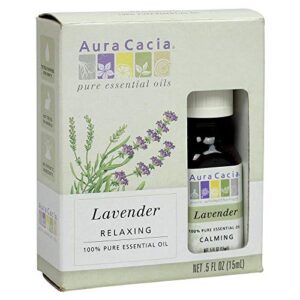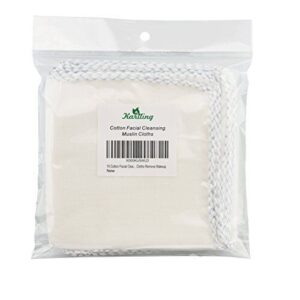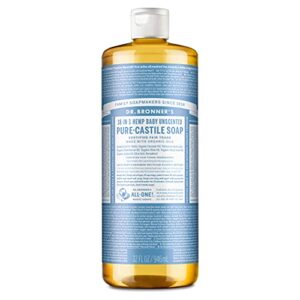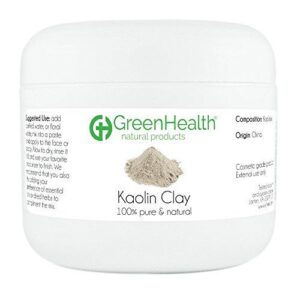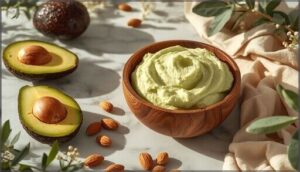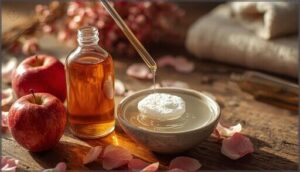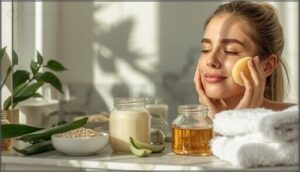This site is supported by our readers. We may earn a commission, at no cost to you, if you purchase through links.
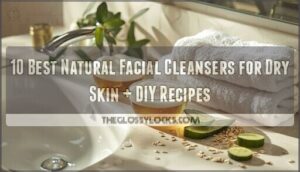
Cracked cheeks that sting in the cold. Tightness after every wash. If you know the feeling, you aren’t alone—dry skin demands more than wishful thinking and a pretty label.
What your face truly craves goes deeper: real ingredients that nourish, shield, and restore balance, not strip it away. From coconut oil’s silky barrier to honey’s gentle touch, the right natural facial cleanser for dry skin offers comfort and science in each drop.
Discover new ways to care for your skin, skip the guesswork, and find what brings real relief—beginning with solutions tested by time and guided by clinical detail.
Table Of Contents
- Key Takeaways
- Best Natural Facial Cleansers for Dry Skin
- 1. Foods That Harm Foods That Heal
- 2. Extraordinary Uses for Ordinary Things Book
- 3. NOW Solutions Organic Jojoba Oil
- 4. Pura D’Or Organic Tamanu Oil
- 5. NOW Frankincense Essential Oil Aromatherapy
- 6. Aura Cacia Pure Lavender Essential Oil
- 7. Cotton Muslin Facial Cleansing Cloths
- 8. Dr Bronner’s Baby Unscented Castile Soap
- 9. Quaker Organic Old Fashioned Rolled Oats
- 10. GreenHealth Natural Kaolin Clay Powder
- Essential Ingredients for Dry Skin Cleansers
- DIY Natural Cleanser Recipes for Dry Skin
- How to Choose The Right Cleanser
- Proper Facial Cleansing Techniques
- Frequently Asked Questions (FAQs)
- Conclusion
Key Takeaways
- Dry skin needs a cleanser with gentle, nourishing ingredients like oils, honey, and oats to hydrate and protect your skin barrier instead of stripping it.
- Choosing and adjusting your cleanser should be based on your skin’s current needs, season, and whether you wear makeup, with a focus on avoiding harsh chemicals, sulfates, and fragrances.
- Simple DIY recipes using kitchen staples such as coconut oil, yogurt, or kaolin clay can hydrate, soothe, and support your skin’s natural barrier when used safely.
- Proper cleansing habits—using lukewarm water, gentle techniques, and moisturizing immediately afterward—help prevent dryness and keep your skin healthy.
Best Natural Facial Cleansers for Dry Skin
When your skin feels tight and parched, the right cleanser can make all the difference between relief and more irritation. Natural options work with your skin’s barrier instead of stripping it, helping you maintain moisture while still getting clean.
The right natural cleanser can turn tight, parched skin from irritation to relief by locking in moisture instead of stripping it away
Here are ten products and ingredients that support dry skin without harsh chemicals or unnecessary additives.
1. Foods That Harm Foods That Heal
Your skin reflects what you put in your body. Sugar and breakouts go hand in hand—processed foods spike blood glucose, triggering acne and robbing your skin of moisture.
Healthy fats like omega-3s from fish and nuts are essential for skin hydration and elasticity. Nutrient-dense foods such as leafy greens and berries support natural repair from within.
While dietary restriction can reduce inflammation, loading up on whole foods improves dryness by over 30%. Hydration importance can’t be overstated—drink at least eight glasses daily to maintain your skin’s protective barrier.
Best For: Anyone looking to understand how everyday food choices affect their skin health and want practical guidance on eating for clearer, more hydrated skin.
- Covers more than 170 foods with actionable tips on preparation and storage to maximize healing benefits for your skin and overall health.
- Includes over 50 updated recipes and 100 health condition entries, making it easy to target specific issues like acne, dryness, or inflammation through diet.
- Affordable at $14.88 and offers a comprehensive approach connecting food to wellness, backed by research on nutrients like omega-3s and antioxidants.
- Some recipes may include controversial ingredients like canola oil, which certain readers consider inflammatory and unsuitable for skin health.
- Book condition can be inconsistent—some customers report receiving damaged or dirty copies.
- Content may feel outdated or incomplete for readers with specific dietary restrictions or those seeking the latest nutritional science.
2. Extraordinary Uses for Ordinary Things Book
One of the smartest investments for DIY skincare is Reader’s Digest’s “Remarkable Uses for Ordinary Things.” This book offers over 2,300 household item uses, including natural face wash solutions that cost under $1 per application.
You’ll find moisturizing recipes using vinegar, oatmeal, and honey—all proven ingredients for dry skin. The book’s updated editions reach millions seeking affordable alternatives to commercial cleansers.
Following its natural skincare tips can reduce your beauty spending by 70% while supporting hydrating, gentle care your skin actually needs.
Best For: People who want to save money on skincare and cleaning products by using natural household items they already own.
- Contains over 2,300 practical uses for everyday items like vinegar, oatmeal, and honey that cost less than $1 per use compared to store-bought products.
- Offers proven natural skincare solutions that can reduce beauty spending by up to 70% while being gentle on skin.
- Available in multiple formats including physical book, Kindle, and large-print editions for easy reference whenever you need it.
- Some items and tips are geared toward American households and may not translate well to other countries.
- Works better as a reference guide than a cover-to-cover read, so it might not suit everyone’s reading style.
- Much of the information can be found online for free, though having it all in one place is convenient.
3. NOW Solutions Organic Jojoba Oil
If you’re searching for a natural face cleanser that’s gentle yet effective for dry skin, NOW Solutions Organic Jojoba Oil stands out. Its organic certification assures purity, while moisturizing efficacy is backed by glowing consumer reviews—users consistently praise its softening touch and non-greasy finish.
Jojoba oil mimics your skin’s own sebum, balancing hydration without clogging pores. For DIY skincare, it works as both a standalone moisturizer and a carrier oil. Application guidelines recommend daily use for best results.
Best For: Anyone with dry or sensitive skin looking for a pure, organic moisturizer that absorbs quickly without leaving a greasy residue.
- 100% USDA organic jojoba oil that mimics natural skin sebum, making it ideal for balancing hydration and improving skin softness.
- Backed by strong consumer ratings (4.8/5 stars) and clinical research showing anti-inflammatory and antimicrobial benefits for conditions like eczema and acne.
- Multi-purpose formula works as a facial moisturizer, hair treatment, and carrier oil for DIY skincare blends.
- Dispenser design can be messy and may leak when closing the bottle.
- Unscented formula might not appeal to those who prefer fragrant oils.
- Applying too much can leave a greasy feel, requiring careful dosing for best results.
4. Pura D’Or Organic Tamanu Oil
If jojoba oil leaves you wanting deeper hydration, PURA D’OR Organic Tamanu Oil may be what your dry skin needs. Rich in moisturizing ingredients and antioxidants, tamanu oil benefits include wound healing, UV protection, and improved skin elasticity. Its hypoallergenic, organic formula absorbs quickly, making it a gentle natural face wash for sensitive skin. However, those with nut allergies should patch test first.
With market growth driven by demand for natural skincare ingredients, tamanu oil stands out for its unique blend of soothing and reparative properties.
Best For: People with dry or mature skin looking for a natural oil that deeply moisturizes, helps fade scars and dark spots, and supports skin healing without clogging pores.
- Fast-absorbing formula rich in fatty acids and antioxidants that hydrate skin while improving elasticity and reducing signs of aging.
- Clinically shown to speed up wound healing and reduce inflammation, making it useful for acne scars, blemishes, and irritated skin.
- USDA certified organic and cruelty-free, with natural antimicrobial properties that protect against skin bacteria.
- Strong nutty, earthy scent that some users find unpleasant and overpowering during application.
- May be too heavy for oily or acne-prone skin types, potentially leading to breakouts despite being non-comedogenic.
- Not suitable for people with tree nut allergies, and patch testing is recommended due to occasional allergic reactions.
5. NOW Frankincense Essential Oil Aromatherapy
Frankincense brings a gentle touch to dry skin routines, offering soothing, anti-inflammatory benefits. NOW’s oil, which meets strict purity standards, is particularly prized for its moisturizing and tissue-repair qualities. It’s a key ingredient in natural face wash blends and DIY face masks.
Beyond its use in skincare, frankincense is valued in aromatherapy applications. It helps calm redness and supports cell renewal, extending its benefits beyond relaxation.
With sustainable sourcing and rising consumer preferences for essential oils, frankincense emerges as a smart, restorative choice. It’s ideal for both daily care and special treatments.
Best For: People with dry or mature skin looking for a natural, anti-inflammatory oil to support skin repair and add to DIY skincare routines.
- Pure frankincense oil with proven anti-inflammatory and skin-regenerating properties, backed by clinical studies showing reduced redness and improved healing in conditions like eczema.
- Versatile for aromatherapy, massage, and mixing into homemade face washes, moisturizers, or all-purpose cleaners.
- Sustainably sourced and vegan, meeting the growing demand for clean beauty products with transparent, natural ingredients.
- Highly concentrated formula requires dilution with a carrier oil before applying to skin, which adds an extra step for beginners.
- Some users report quality control inconsistencies, including receiving diluted blends instead of 100% pure oil.
- The scent may vary from other frankincense brands and might not appeal to everyone’s preferences.
6. Aura Cacia Pure Lavender Essential Oil
Lavender oil benefits stretch far beyond its soothing scent. Aura Cacia Pure Lavender Essential Oil stands out for dry skin, forming a gentle barrier to boost skin hydration.
In natural face wash blends, its anti-inflammatory and antimicrobial properties help calm irritation and support healing. You’ll appreciate its product quality—each batch is rigorously tested for purity.
Still, safety concerns matter: always dilute essential oils to avoid reactions. If you value natural skincare ingredients and aromatherapy applications, this moisturizing ingredient deserves a spot in your routine.
Best For: People who want a pure, well-tested lavender essential oil for natural skincare, aromatherapy, and gentle moisture support.
- USDA Organic and cruelty-free, with traceable sourcing for peace of mind
- Proven moisturizing and soothing effects for dry, irritated skin
- Strong antimicrobial and healing properties for skin and home use
- Can cause skin reactions or irritation if not properly diluted
- May trigger photosensitivity, especially when mixed with citrus oils
- Not safe for ingestion and may cause hormonal effects in sensitive individuals
7. Cotton Muslin Facial Cleansing Cloths
With muslin exfoliation, you get more than just surface cleansing. These cloths gently boost micro-circulation and cell turnover, making dry skin look brighter and feel smoother.
Their soft weave promotes Sensitive suitability, won’t disrupt your skin’s microbiome, and avoids harsh abrasives common in other Gentle Skin Cleansers.
Eco-friendliness is a bonus: reusable cotton muslin reduces waste and ocean pollution. Quality statistics show high satisfaction, with cloths maintaining softness for months.
Pair with Natural Face Wash for a truly effective, moisturizing routine.
Best For: Anyone with sensitive or dry skin who wants a gentle, eco-friendly way to cleanse and exfoliate their face.
- Reusable and biodegradable, cutting down on waste compared to disposable wipes.
- Gentle exfoliation that helps brighten skin without irritation.
- Maintains softness and effectiveness for months with proper care.
- Some users find the cloths too thin or rough for their liking.
- Not as absorbent as thicker washcloths.
- Needs careful washing (like using a lingerie bag) to prevent wear and tear.
8. Dr Bronner’s Baby Unscented Castile Soap
Ever wondered if a gentle cleanser could truly respect your skin’s limits? Dr Bronner’s Baby Unscented Castile Soap stands out as a Natural Face Wash for Dry Skin. Its ingredient purity standards—organic oils, no synthetic additives—reduce skin irritation risk and support Sensitive skin usage.
Double olive oil content means extra Moisturizing, while eco-friendly packaging appeals to conscious choices. Remember, it’s 3x concentrated; proper dilution and ratios matter.
This Gentle Cleanser’s versatility and clean rinse make it a staple for those seeking Castile soap benefits.
Best For: People with dry, sensitive, or allergy-prone skin—including babies and adults—who want a gentle, fragrance-free cleanser.
- Made with certified organic and fair trade ingredients, safe for sensitive skin and babies
- Highly versatile; works for face, hair, laundry, dishes, and even pets
- Eco-friendly packaging and concentrated formula make it cost-effective and sustainable
- Needs to be diluted for most uses, which can be inconvenient
- Unscented formula may not appeal to those who prefer a fragranced soap
- May not tackle tough cleaning jobs without extra ingredients or adjustments
9. Quaker Organic Old Fashioned Rolled Oats
Did you know oatmeal’s natural saponins gently cleanse while locking in moisture? Quaker Organic Old Fashioned Rolled Oats deliver proven oatmeal benefits—think skin hydration, barrier repair, and less irritation.
Clinical studies show colloidal oatmeal soothes dry skin fast, reducing flakiness and itch. As a natural face wash, these oats are hypoallergenic and packed with ingredients that protect and moisturize.
You won’t strip your skin; instead, you’ll nourish it, supporting a smoother, calmer complexion every time you cleanse.
Best For: Adults seeking a natural, organic option for both breakfast and gentle skincare, especially those with dry or sensitive skin.
- USDA Organic, non-GMO, and sodium-free for clean, healthy eating or skincare.
- Clinically proven to soothe, hydrate, and protect dry, irritated skin.
- Versatile—great for meals, snacks, and DIY facial cleansers.
- Only available in one flavor, which may limit variety.
- May be pricier due to import costs or organic certification.
- Not suitable for those with oat allergies or specific dietary restrictions.
10. GreenHealth Natural Kaolin Clay Powder
Looking for a gentle, natural face wash that won’t upset your dry skin? GreenHealth Natural Kaolin Clay Powder stands out for its purity and mild touch.
Kaolin clay benefits include soft exfoliation and oil absorption, all while maintaining your skin’s moisture. This clay’s fine texture means it won’t strip or irritate—making it ideal for dry skin care routines.
Consumer feedback highlights smoother, less flaky skin after use. Application safety is high, and its ingredients meet strict standards for purity and moisturizing support.
Best For: People with dry or sensitive skin looking for a gentle, natural way to cleanse and soften their face.
- Soft exfoliation that helps smooth and hydrate skin
- Pure, cosmetic-grade clay with high safety standards
- Easy to mix and use for masks, scrubs, and more
- May stain fabrics if not rinsed carefully
- Not as absorbent as other clays for heavy oil control
- Some users feel the jar size is small for the price
Essential Ingredients for Dry Skin Cleansers
When your skin feels tight or flaky, the right ingredients make all the difference. Some natural options offer real relief and protection for dry skin.
Here’s what to look for when choosing a gentle, effective cleanser.
Benefits of Coconut Oil for Hydration
A drop of coconut oil can make all the difference for dry skin. Thanks to its lauric acid, this natural face cleanser acts as a mild surfactant, lifting impurities without stripping moisture. Used as a cleansing balm, coconut oil increases lipid content and skin hydration, but its comedogenicity score means it’s best for non-acne-prone areas.
Coconut oil also offers antimicrobial properties, providing a defense against certain bacteria.
- Locks in moisture
- Smooths flaky skin
- Gently removes makeup
Honey’s Moisturizing and Antibacterial Properties
Honey brings two major benefits when used as a natural face cleanser for dry skin: moisturizing power and antibacterial effectiveness. Its high viscosity forms a protective layer that accelerates healing and retains hydration, supporting your skin barrier. Using a cleanser with harsh ingredients can strip away natural oils, leading to dryness. Lab tests confirm antibacterial action against bacteria like E. coli and S. aureus, thanks to honey’s osmolarity and hydrogen peroxide production.
| Benefit | How It Works |
|---|---|
| Moisture Retention | Creates a protective barrier layer that locks in hydration |
| Antibacterial Action | Hydrogen peroxide inhibits bacteria up to 24 mm zone diameter |
| Wound Healing | Maintains moist environment for faster tissue repair |
Role of Yogurt in Skin Rejuvenation
If honey is your skin’s first aid, yogurt is your gentle restorer. Yogurt masks smooth rough patches and lighten sun damage, thanks to lactic acid’s mild exfoliation. You’ll notice better skin elasticity and softer texture with regular use.
For dry skin, a natural face cleanser with yogurt offers:
- Moisturizing
- Pore tightening
- Skin soothing
- Age spot fading
- Homemade skincare simplicity
Apple Cider Vinegar for Gentle Exfoliation
If yogurt calms, apple cider vinegar (ACV) gently renews. ACV benefits dry skin by exfoliating with alpha-hydroxy acids, supporting pH balance, and keeping your skin’s acid mantle healthy. For sensitive skin, dilute ACV—usually 1 part vinegar to 3 parts water—and use as a DIY face wash just twice weekly.
| ACV Benefits | Exfoliation Frequency |
|---|---|
| pH Balance | 2x Weekly |
| Dilution Ratios | 1:3 (ACV:Water) |
Soothing and Nourishing Plant Oils
Comfort for your skin starts with plant-based ingredients. Natural oils like jojoba, tamanu, and almond deliver essential fatty acids that support skin barrier repair and soften chronic dry skin. Plant-based occlusives in a natural face wash help lock in moisture, calm inflammatory response, and keep your skin resilient.
- Gentle hydration
- Lasting softness
- Reduced redness
- Nourishing protection
DIY Natural Cleanser Recipes for Dry Skin
If you want to care for dry skin with ingredients from your own kitchen, you have plenty of gentle options. These simple recipes can help hydrate, soothe, and support your skin’s natural barrier.
Here are a few you might want to try.
Coconut Oil Cleansing Balm Recipe
Ever wondered why coconut oil cleansing balms top DIY cleansing balm recipes for dry skin? Their rich DIY Balm Texture melts away makeup and dirt, yet boosts hydration—outperforming water-based cleansers.
While coconut oil’s comedogenicity means patch testing is wise, adding Shelf Life Extenders and Essential Oil Additives keeps your natural face cleanser fresh.
Balm Market Trends show growing demand for these nourishing formulas.
Honey and Yogurt Hydrating Cleanser
A natural facial cleanser combining raw honey and plain yogurt offers dry skin a boost in hydration and microbiome balance. Yogurt probiotics impact skin renewal, while honey’s enzymes exfoliate gently. Try this DIY honey cleanser recipe for overnight mask benefits and moisturizing comfort. For safe results, patch test first.
- Raw honey selection
- Yogurt probiotics impact
- DIY cleanser safety
- Overnight mask benefits
- Skin microbiome balance
Gentle Oat and Kaolin Clay Powder Cleanser
Looking for a gentle touch that won’t leave your skin parched? Oat benefits and clay properties combine in this powdered facial cleanser, offering mild exfoliation and barrier support.
Just activate the powder with water—DIY variations let you adjust for different skin types.
This natural face cleanser delivers hydration and comfort, making it ideal for dry skin and sensitive DIY face wash routines.
Avocado Oil and Almond Mayonnaise Scrub
Did you know a scrub can do more for dry skin than most creams? The avocado oil and almond mayonnaise scrub blends rich oil composition with exfoliation. You’ll notice smoother, firmer skin—thanks to almond benefits and improved skin firmness. For best results, use this DIY face wash two to three times weekly.
- Scrub Application
- Oil Composition
- Almond Benefits
- Skin Firmness
- Usage Frequency
Apple Cider Vinegar Toner for Dry Skin
Did you realize apple cider vinegar needs careful ACV dilution for dry skin? Matching your skin pH helps, but irritation risks are real. Most dermatologists recommend a 0.5–1% solution, followed by moisturizing.
User tolerance varies—watch for stinging or redness. Recipe additives like rosewater can soothe, but always patch test your natural face cleanser to protect your pH balance.
How to Choose The Right Cleanser
Choosing the right cleanser for dry skin isn’t always straightforward. Your skin’s needs can shift with the seasons, your age, and even how much makeup you wear.
Here’s what to look for before picking your next face wash.
Identifying Your Skin Type and Needs
How do you really know if your skin is dry? Start by observing visible signs: flaking, rough texture, or that tight feeling after washing. About 29% of adults have xerotic (dry) skin, often linked to age, genetic predispositions, or environmental skin impact. Understanding your dry skin helps you choose moisturizing ingredients that support skin moisture and barrier repair.
To identify your skin types and needs:
- Check for visible flakes using the “chalkboard test”
- Monitor skin hydration levels after cleansing
- Note any itching or tightness
- Consider cleanser ingredient sensitivities
- Seek professional skin analysis if uncertain
Seasonal Changes and Cleanser Selection
If your skin feels tight in winter but slick in summer, you’re not alone. Winter dryness calls for richer, moisturizing cleansers, while summer sebum benefits from lighter, natural face cleanser options. Routine adjustments matter—seasonality and cleanser selection go hand in hand. Dermatologist advice? Adapt with seasonal ingredients. Here’s a quick guide:
| Season | Cleanser Type | Key Ingredient |
|---|---|---|
| Winter | Cream/Oil | Coconut Oil |
| Summer | Gel/Foam | Yogurt |
| Spring | Lightweight | Honey |
| Autumn | Balm | Avocado Oil |
| All | DIY Recipes | Kaolin Clay Powder |
Key Ingredients to Avoid for Dry Skin
Just as colder months demand richer hydration, your cleanser should skip harmful chemicals that worsen dry skin. Watch for harsh sulfates—they strip away protective oils, while drying alcohols and parabens risks raise skin sensitivity.
Synthetic fragrances often spark irritation, and acid exfoliants can leave your face flaky. Choosing gentle formulas helps you sidestep ingredients to avoid and keep irritation at bay.
Adjusting Cleansers for Age and Makeup Use
Choosing cleansers means matching your age and makeup habits with what your skin needs. For dry skin, age-specific formulas and natural ingredients matter more as you grow older. If makeup removal is part of your routine, hydration emphasis and texture preferences help protect your barrier. Adjust cleansing frequency and look for antiaging benefits. Try:
- Cream-based cleansers
- Oil blends
- Peptide-rich formulas
- Gentle makeup removers
- Hydrating textures
Proper Facial Cleansing Techniques
Cleansing your face the right way can make all the difference, especially if your skin feels tight or flaky. Small changes in your routine help protect and hydrate dry skin.
Here’s how you can care for your face with a few practical steps.
Step-by-step Face Washing Method for Dry Skin
Ever wondered why lukewarm water feels best for dry skin? It’s not just comfort—ideal water temperature preserves hydration.
Use a pea-sized cleanser amount, then gently massage in circles for 30–60 seconds. Rinsing time matters; 15–20 seconds removes residue.
Patting technique is key: always pat dry with a soft towel, never rub, to protect your skin barrier.
Common Mistakes to Avoid
With dry skin, missteps like Over-Cleansing or reaching for a harsh ingredient-laden face wash can undo your hard work. Using hot water or scrubbing too vigorously strips natural oils, leaving your skin vulnerable.
Over-Exfoliation often causes irritation instead of renewal. And neglecting moisturizer after your natural face cleanser? That’s how dryness and discomfort start to weave in.
The Importance of Rinsing and Patting Dry
After you rinse your natural face cleanser away, water temperature and thoroughness matter more than you might think. Lukewarm water preserves your skin barrier, while hot water raises dryness risk.
Clinical guidelines stress complete residue removal—leftover surfactants can spike transepidermal water loss by 23%. Pat gently with a soft towel instead of rubbing. This simple step maintains skin hydration, reduces irritation, and furthers the moisturizing benefits you need.
Following Up With Toners and Moisturizers
Think of your skin as a thirsty sponge—after cleansing, it’s primed to soak up hydration. Applying a hydrating toner boosts toner hydration levels and preps your skin to lock in moisture.
Follow up with moisturizer while skin is still damp; this timing maximizes moisturizing benefits and layering product efficacy, supporting your skin care routine and improving dry skin resilience.
Storage Tips for Homemade Cleansers
It only takes one stray germ to spoil your homemade cleanser faster than you’d think. For long-lasting results, pay attention to:
- Container sterilization before every batch
- Using airtight, opaque packaging to minimize exposure
- Strict temperature control, like refrigerating water-based blends
- Ingredient variations that shorten or lengthen shelf life
Stay vigilant—natural ingredients invite microbial risks, but smart homemade cleanser storage keeps skin and formulas healthy.
Frequently Asked Questions (FAQs)
How do natural cleansers compare to commercial brands?
Both natural cleansers and commercial brands offer pros and cons. Efficacy comparison hinges on your skin’s needs—natural face washes prioritize ingredient safety, long-term effects, and hydration levels, while commercial options may yield swifter, more targeted results for some skin types.
Can natural cleansers help with eczema or dermatitis?
Picture waking up with itching and redness—eczema doesn’t just fade with time.
Research shows gentle natural face washes, especially those with colloidal oatmeal or natural oil benefits, can soothe sensitive skin and reduce irritation risk factors without harsh additives.
Are fragrance-free natural cleansers safer for allergies?
Yes, but watch for Hidden Allergens. Even fragrance-free natural face wash contains sensitizers like essential oils or botanical extracts.
Over 94% of “natural” products had allergens despite Misleading Labels, increasing allergy risk for sensitive skin.
How often should you use a natural face cleanser?
Much like watering a delicate houseplant, Cleansing Frequency for your face depends on dryness and sensitivity.
Once nightly with a Gentle Cleanser—factoring in Seasonal Adjustments and Product Ingredients—protects your barrier and respects Individual Needs.
What preservatives can be used in homemade cleansers?
To keep your DIY facial cleanser fresh, choose natural preservatives like potassium sorbate or sodium benzoate for water-based recipes. Opt for antioxidants in oil-based cleansers.
pH, antimicrobial boosters, and ingredient compatibility help ingredients stay safe and effective.
Conclusion
Choosing, crafting, and caring—each step shapes your skin’s comfort. When you reach for a natural facial cleanser for dry skin, you choose more than a product; you choose gentle science and daily intention.
Let each ingredient—oat, oil, honey—remind you that real care happens drop by drop, habit by habit. Release the old trial and error. Welcome skin that feels right, not just looks right, every single day.
Hydration and health can begin with the way you cleanse.
- https://www.databridgemarketresearch.com/reports/north-america-facial-cleanser-market
- https://www.reanin.com/reports/facial-cleansers-and-toners-market
- https://www.ijord.com/index.php/ijord/article/download/1766/982/8759
- https://www.cureus.com/articles/393914-clinical-evaluation-of-a-soap-free-cleansing-lotion-containing-sodium-cocoyl-apple-amino-acids-for-effective-impurity-removal-and-skin-barrier-preservation-in-healthy-adults-with-diverse-skin-types
- https://cdn.clinicaltrials.gov/large-docs/67/NCT04724967/Prot_001.pdf




